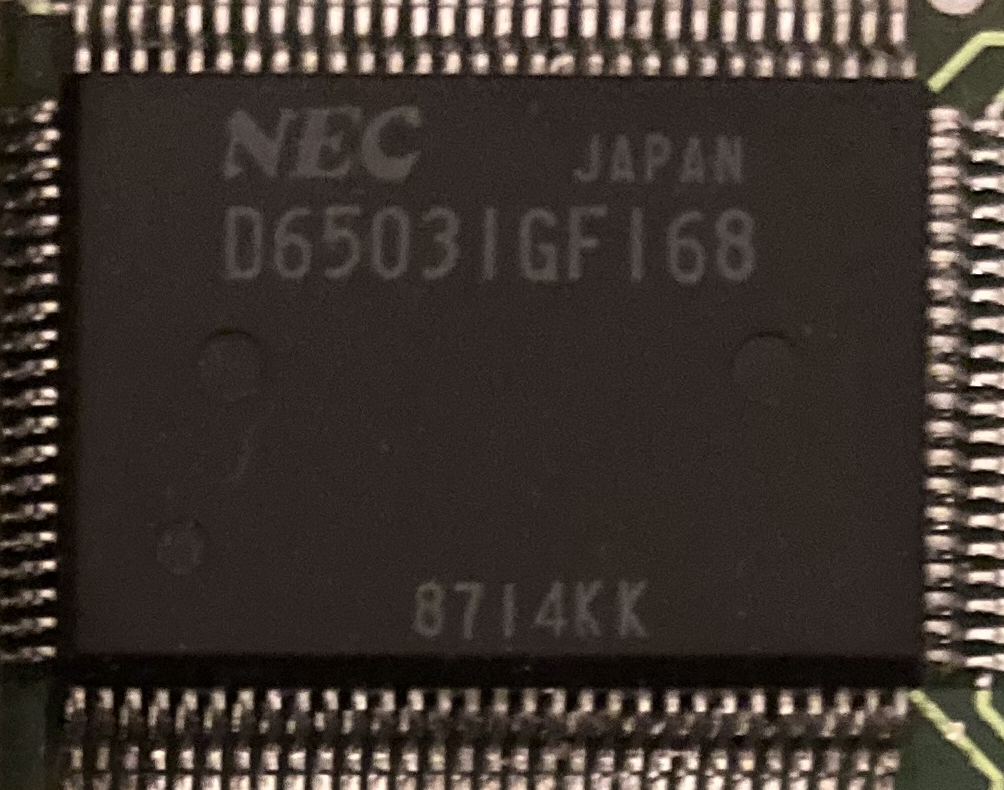The Blink gate-array is a custom ASIC : NEC D65031GF168. This SMD is a uPD65000 series (low power 2 micron ASIC) with 138 rows of 24 columns, 3312 cells of 4 transistors.
GF stands for a flat packaging of 100 pins. 168 is the circuit type number identifying the blink design.
It contains the logic of :
the memory management unit (MMU)
the real time clock (RTC)
the Z80 clock and power management
the Z80 reset
the programmable interrupt controller (PIC)
the UART
the LCD controller
the EPROM programmmer
the speaker
Pin Name Type Description 1 GND - Ground 2 VDD - +5V 3 IOR I Z80 /IORQ 4 CRD I Z80 /RD 5 MRQ I Z80 /MREQ 6 HLT I Z80 /HALT 7 NMIB O Z80 /NMI 8 INTB O Z80 /INT 9 CDB IO Z80 D1 10 ROUT O Z80 /RST 11 CDA IO Z80 D0 12 CM1 I Z80 /M1 13 CDH IO Z80 D7 14 CDC IO Z80 D2 15 CA0 O Z80 A0 16 CDG IO Z80 D6 17 CA1 O Z80 A1 18 CDF IO Z80 D5 19 CA2 O Z80 A2 20 CDD IO Z80 D3 21 CA3 O Z80 A3 22 CDE IO Z80 D4 23 CA4 O Z80 A4 24 CA5 O Z80 A5 25 CA15 O Z80 A15 26 CA6 O Z80 A6 27 CA14 O Z80 A14 28 GND - Ground 29 VDD - +5V 30 CA13 O Z80 A13 31 CA7 O Z80 A7 32 CA8 O Z80 A8 33 CA12 O Z80 A12 34 CA9 O Z80 A9 35 CA11 O Z80 A11 36 CA10 O Z80 A10 37 TxD O UART TXD 38 RTS O UART RTS 39 IRCE O RAM.0 /CE 40 GND - Ground 41 RxD I UART RXD 42 CTS I UART CTS 43 DCD I UART DCD 44 PM1 O Z80 clock (3.2768 MHz) 45 LP O LCD control, 10ms line pulse 46 FR O LCD control, 156us frame 47 XSCL O LCD control, 300ns data 48 LD0 O LCD data 49 LD1 O LCD data 50 LD2 O LCD data 51 LD3 O LCD data 52 VDD - +5V 53 GND - Ground 54 MA16 O Memory A16 55 MA15 O Memory A15 56 MA14 O Memory A14 57 MA12 O Memory A12 58 MA7 O Memory A7 59 MA13 O Memory A13 60 MA6 O Memory A6 61 MA8 O Memory A8 62 MA5 O Memory A5 63 WRB O Write enable /WE 64 MA9 O Memory A9 65 MA4 O Memory A4 66 MA11 O Memory A11 67 MA3 O Memory A3 68 IPCE O ROM.0 /CE 69 MA2 O Memory A2 70 MA10 O Memory A10 71 MA1 O Memory A1 72 MA0 O Memory A0 73 MDH IO Memory D7 74 MDA IO Memory D0 75 MDG IO Memory D6 76 MDB IO Memory D1 77 MDF IO Memory D5 78 MDC IO Memory D2 79 VDD - +5V 80 GND - Ground 81 MDE IO Memory D4 82 MDD IO Memory D3 83 MA17 O Memory A17 84 MA18 O Memory A18 85 MAW O Memory A19 86 SE1 O Slot1 /CE 87 POE O PSRAM /OE (refreshed) 88 ROE O ROM /OE 89 PGMB O Slot 3 /WE (Program Byte) 90 EOE O Slot 3 /OE (Eprom OE) 91 SE3 O Slot 3 /CE 92 FLP I Flap 93 SE2 O Slot2 /CE 94 SNS I Sens line (card insertion) 95 VPON O VPP on 96 BTL I Batt low 97 RIN I Reset input 98 MCK I Master clock (9.8304 MHz) 99 SCK I Standby clock (25.6 KHz) 100 SPKR O speaker
The original notes as supplied to Cambridge Computer were lost during the time of the company's move from Cambridge to Scotland.
SNS
Card insertion or removal is detected by SNS. This feature was patented by James Westwood (#WO8809573, 1988-12-01). When SNS goes low, an NMI is fired and initiate a shutdown. This prevent any loss off data or system crash.
POE, ROE, EOE, pseudo-static RAM refresh
POE : Pseudo-static OE
ROE : Rom OE
EOE : Eprom OE
When Z80 is running and LCD is on, the refresh is performed by the LCD controller reading the memory.
When LCD is off (DOZE state), the 42832 is not in standby mode, it needs to be refreshed.
POE provides this refresh, ROE does not. POE is tracked to slot 0 RAM, slot 1 and slot 2 connectors.
Pseudo static RAM card are not supported in slot 3. The POE line in slot 3 connector is replaced by the EOE. EOE is driven by the EPR register.
Z80 Refresh signal is not wired. Refresh logic in blink is done from CRD, CM1, MRQ (negative signals) :
POE = ROE | ( CRD & ~CM1 & ~MRQ)
Clocks and power management
Z80 clock (PM1) is driven by the Blink, the CMOS Z80 can be stopped without losing register state.
Active : PM1 = MCK / 3 = 9.8304 / 3 = 3.2768MHz
Snooze : PM1 is stopped
Coma : PM1 = SCK = 25.6KHz
Master clock is 9.83MHz because LCD controller has to read screen files in memory.
LCD controller
A 640 bits shift register is used to build the current line and shift nibbles to the LCD data lines.
The LCD frame rate is 100Hz, one page every 10ms (LP).
One line is sent every 156.25us (FR). A burst of 160 nibbles at 3.2768 MHz (300ns period) are sent. It last 48us and is followed by a 108.25us inactive period.
